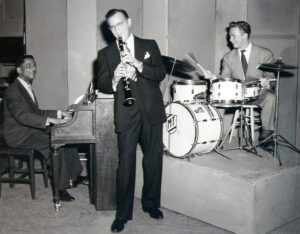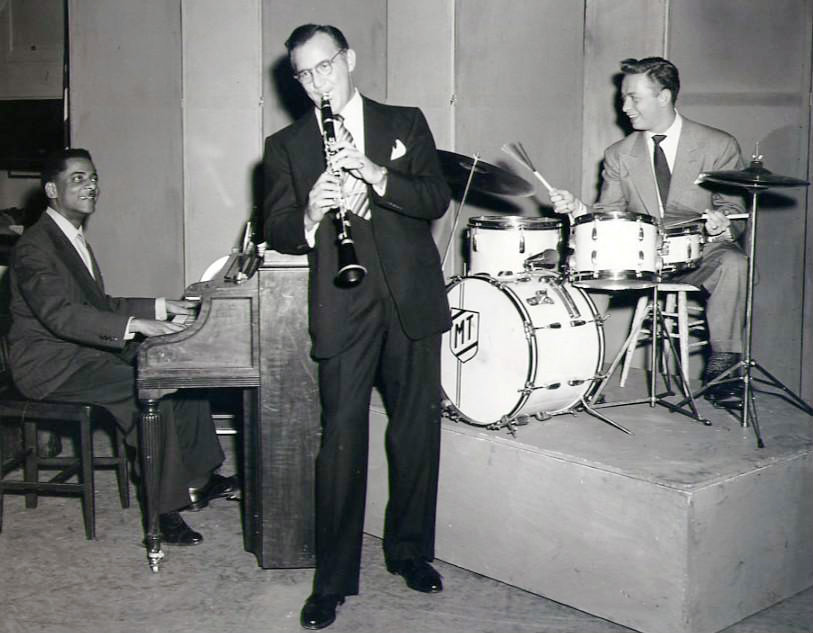
The Beginner’s Guide To Teddy Wilson
by
Ron Drotos
To me, Theodore “Teddy Wilson” is the quintessential pianist from the Swing Era in jazz. I say this because the Swing Era of the 1930s and early 40s was when jazz and popular music merged into a single sound, and Wilson’s playing represents the pinnacle of how to play those songs in a jazz style on piano.
Teddy Wilson was born on November 24, 1912 and lived until 1986. (I actually tried to get a piano lesson with him in 1982 but he wasn’t in good health at the time.) He began his career by working briefly with Louis Armstrong and Earl Hines, both of whom had helped shape the jazz scene of the 1920s. But his big professional break came when he joined Benny Goodman’s Trio in 1935. This was huge! At the time, Benny Goodman was one of the most famous bandleaders in the United States and the trio, which played during the big band’s intermissions, was one of the very first prominent racially-mixed musical groups in America.
Here’s the trio’s 1935 recording of “Body And Soul.” Remember that people would dance to a performance like this.
We don’t hear many jazz trios like this anymore, with drums but not a bassist. The reason the instrumentation works here is because Teddy Wilson played a full-sounding stride pattern with his left hand, which was very typical of the period. Since the left hand alternated between low bass notes and mid-register chords, it effectively played two roles; that of a bass player and also a chordal instrument.
Wilson also teamed up with vocalist Billie Holiday to make some of the best small-group jazz recordings of all time. Holiday was just starting out, and these recordings featured the group as a whole instead of being predominantly vocal arrangements with instrumental backup. Here’s one of their classics, “Easy Living,” from 1937. It also features tenor sax giant Lester Young and the rhythm section from the Count Basie band. Notice how well Wilson “holds it all together,” by playing a sparking piano intro and then playing melodic fills throughout. He injects his musical personality throughout the whole recording, but always in a way that elevates the sound as a whole without “showing off” or pulling focus from the other musicians. And check out his wonderful piano solo which begins at 1:17. He plays a “jazzy” solo while never losing sight of the song’s melody, which he embellishes freely. In fact, all of the musicians here accomplish a perfect marriage of jazz and popular music that is perhaps unequalled anywhere else.
This makes me smile every time I hear it!
Wilson and Holiday reunited for a piano/vocal duet a decade later, when she won the Golden Esquire Award in 1947. This is a rare opportunity to hear how a pianist of Teddy Wilson’s caliber accompanied a singer in a duet format. Even though vocalists often performed with only piano accompaniment in their regular club gigs, the record companies usually assembled instrumental groups for them to record with, as we heard on “Easy Living,” above.
Here’s their piano/vocal performance of Gershwin’s “The Man I Love.”
Wilson also recorded with Lester Young again on their album “Pres And Teddy,” which was recorded in 1956. Let’s listen to their version of the jazz standard “All Of Me.” Wilson’s extended solo here gives us a clear perspective on his style. On the one hand, we can hear elements of the earlier jazz of the 1920s, as represented by Earl Hines. At 2:31, Wilson played a descending figure, in octaves, that clearly evokes Hines’ “trumpet style” piano playing. But at the same time, Wilson’s overall sound is clearly based on a single-note melodic concept that has a characteristic Swing Era rhythmic feel while anticipating the music of the early beboppers.
We can learn a lot about how to play “All Of Me” from both Young and Wilson on this recording!
https://www.youtube.com/watch?v=OZdqEONw_co
In addition to being a wonderful ensemble musician, Wilson was an influential solo pianist. As you’ll hear in this version of “A Ghost Of A Chance,” he had an elegant way of shaping each phrase. In fact, many listeners considered his playing to be so “perfect” that he was often compared to Mozart in this respect. In any case, his playing has a sense of “completeness” to it, without being overly busy or virtuosic. It just sounds as it should be!
Finally, here’s Wilson in his later years, performing the Benny Goodman classic “Don’t Be That Way” in an all-star jazz reunion. He still sounds great at this age, and this video gives us a good view of his hands on the keys.
https://www.youtube.com/watch?v=NHeglJzIEDI
As I mentioned at the beginning of this post, I consider Teddy Wilson’s playing to be a model of how to play popular songs from the Great American Songbook era in a jazz style. He respected the original songs while bringing something very special to them in a highly personal yet universal way. So the next time you sit down at the piano to play “Body And Soul” or another old chestnut, think about Teddy Wilson and his musical legacy.
Here’s where you can learn more about Teddy Wilson:
Teddy Wilson Contemplates The Future Of Jazz
A nice audio interview from 1950.
Teddy Wilson Talks Jazz: The Autobiography Of Teddy Wilson
As always, good luck with your jazz piano playing and remember to enjoy every step of the way!
Take your left hand playing to a new level with my free ebook: Left Hand Techniques for Jazz Piano
You’ll also get my weekly jazz newsletter with practice tips and inspiration

